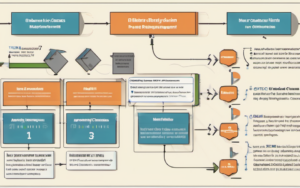It’s hard to imagine a world without blockchain today, but back in the early days, the technology was a mere curiosity, a nascent idea with the potential to revolutionize finance. The concept of a decentralized, immutable ledger seemed like science fiction to many, a far cry from the traditional banking systems we were accustomed to. But the seeds of a revolution were sown, and as we’ll explore, the journey of blockchain from its humble beginnings to its widespread adoption today is a captivating story of innovation, disruption, and the boundless potential of technology.
The Dawn of Decentralization: Bitcoin’s Early Days
A Digital Currency Emerges
The year is 2008. The world is still reeling from the financial crisis, and trust in traditional institutions is at an all-time low. It is in this climate that Satoshi Nakamoto, a pseudonymous individual or group, introduces the world to Bitcoin, a digital currency based on the revolutionary concept of blockchain. Bitcoin was designed to operate outside the control of governments and financial institutions, offering a decentralized alternative to traditional money. While the early days were characterized by skepticism and uncertainty, the idea of a truly peer-to-peer digital currency resonated with a growing number of individuals seeking an alternative to the existing financial system.
The Genesis Block and the White Paper
The genesis block, known as block 0, marked the official birth of Bitcoin. It contained a timestamp, the first transaction, and a message that hinted at the future of the technology: “The Times 03/Jan/2009 Chancellor on brink of second bailout for banks.” This block, along with the accompanying white paper, laid the foundation for what would become a global phenomenon. Nakamoto’s vision of a decentralized digital currency, secured through a cryptographic process known as proof-of-work, captured the imagination of early adopters, sparking the first wave of interest in the technology.
Early Adopters and the Rise of the Bitcoin Community
The early days of Bitcoin were marked by a passionate community of individuals who saw the potential of this new technology. Forums, online communities, and meetups sprung up around the world, fostering a sense of collaboration and excitement. These early adopters, often driven by a desire for financial freedom and technological innovation, helped to shape the nascent Bitcoin ecosystem, contributing to its development and spreading awareness about the possibilities of a decentralized future.
From Niche to Mainstream: Blockchain’s Growing Influence
The Rise of Altcoins and the Expanding Blockchain Ecosystem
Bitcoin’s success paved the way for the emergence of other cryptocurrencies, known as altcoins. Ethereum, Litecoin, and Ripple, among others, emerged in the following years, each offering unique features and functionalities. This diversity contributed to the expanding blockchain ecosystem, fostering innovation and attracting new users to the decentralized space. The evolution of blockchain technology beyond just digital currencies fueled the growth of the industry, opening up new possibilities for applications beyond finance.
Early Applications Beyond Finance: Decentralized Exchanges and Smart Contracts
The initial focus on cryptocurrencies gave way to a broader understanding of blockchain’s potential. Decentralized exchanges (DEXs) emerged, offering a platform for trading cryptocurrencies without relying on centralized intermediaries. Smart contracts, self-executing agreements written on the blockchain, began to find applications in various industries, automating processes and reducing the need for intermediaries. These early applications demonstrated the versatility of blockchain technology and its potential to disrupt traditional business models.
The Growing Interest from Institutions and Governments
The rise of blockchain technology didn’t go unnoticed by institutions and governments. While some governments initially viewed cryptocurrencies with suspicion, others began to explore the potential of blockchain for their own purposes. Financial institutions started experimenting with blockchain for faster and more secure transactions, while governments explored its use in supply chain management, voting systems, and identity verification. This growing interest from established players signaled a shift in perception, moving blockchain from the fringes of the tech world to the forefront of mainstream discourse.
The Future of Blockchain: Beyond Bitcoin
The Potential of Blockchain Technology in Various Industries
The future of blockchain is bright, with the technology poised to revolutionize various industries. In healthcare, blockchain can be used to securely store and share patient records, enabling better data management and personalized medicine. In the supply chain, blockchain can track goods from origin to destination, ensuring transparency and authenticity. In the energy sector, blockchain can facilitate peer-to-peer energy trading, enabling a more efficient and sustainable energy grid. These are just a few examples of how blockchain technology can transform the way we live, work, and interact with the world.
Challenges and Opportunities for Blockchain Adoption
Despite its immense potential, blockchain adoption still faces challenges. Scalability, interoperability, and regulatory uncertainty are some of the key hurdles that need to be addressed. However, the global community of developers, researchers, and entrepreneurs is actively working to overcome these challenges, pushing the boundaries of blockchain technology and creating new opportunities for innovation.
The Evolution of Blockchain and its Impact on the Future
As blockchain technology continues to evolve, we can expect to see even more disruptive applications emerge. From decentralized finance (DeFi) to non-fungible tokens (NFTs), the possibilities are endless. The evolution of blockchain is a journey of continuous innovation, driven by a community that embraces its potential to create a more transparent, secure, and efficient world.
The journey of blockchain from its humble beginnings to its widespread adoption today is a testament to the power of technology to disrupt and transform. As we look towards the future, we can anticipate even more profound changes as blockchain continues to evolve and reshape the world around us.




